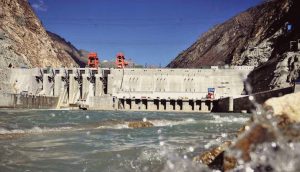China is the big “invisible partner” in the US and Japan-led greater Pacific free trade agreement, signed in Atlanta earlier this month and which includes Mexico, Chile and Peru, according to Peter Hakim, president emeritus of Washington-based think-tank the Inter-American Dialogue. And the pact, which China is expected to have some formal association with, will not adversely affect the relationship between Beijing and Latin America, Hakim says.
China is a notable absentee from the 12 signatories to the Trans-Pacific Partnership agreement (TPP), which covers 40% of the world’s economy and could become the largest regional trade agreement in history. The announcement of the historic pact, which was seen by some as a counterweight to China’s economic power in the region, followed five years of negotiations between the US and Japan conducted largely in secret.
For Hakim, China, which was invited to join the TPP, did not do so for “purely pragmatic” reasons. Building a deal between China and the US “would have been almost impossible,” he said. “Many Americans see China as their rival. It’s not a country that we can describe as a completely free market. A large number of companies are state-run, and the government has a broader role in managing the economy. Creating the rules with China would have been very difficult.”
The agreement does not only outline trade and investment standards but also social and environmental standards, which US president Barack Obama claimed would have the highest of any trade deal in history. It will also affect the exchange of information, intellectual property rights and patents for pharmaceuticals. The new trading bloc covers some 800 million people and is designed to knock down barriers to worldwide economic activity that amounts to US$ 200billion annually.
As the world’s largest exporter, China will not be able to avoid trading with this new bloc, which will be the largest in the world. Sooner or later, the anticipated growth in trade within the bloc will also affect China, says Hakim, who envisions the joining or a possible association within a year or two. Before this can happen, national congresses of the 12 member-countries need to ratify the agreement.
China is the largest or second-largest trading partner for almost all of the TPP countries. “It is a great machine for international trade and has more exports than the US. China’s export capacity is huge. What country doesn’t want to have a relationship with China?” Hakim asks.
Amid concerns that non-TPP member countries from Latin America (and those not included in the Pacific region) might be negatively impacted by the deal and with China standing to gain indirectly from it, Beijing moved to reassure the region that it would continue to prioritise their trade relationship – albeit remaining centrally focused on the export of commodities, the production of which is environmentally degrading.
“Don’t worry, China still has a long period of medium and high growth, and will remain a very important buyer of raw materials, which drive Latin American growth,” said Yi Gang, the vice-president of the People’s Bank of China, just days after the TPP announcement in Atlana, while also saying China remained open to the idea of joining TPP.
Even with the slowdown, China will still grow 6.8% in 2015, and 6.3% in 2016, according to the latest IMF estimates. The rate represents the country’s lowest annual growth in 25 years. “Given the medium to high growth still present in China, we need trade with Latin American countries. They are very important partners. We will continue importing many raw materials, including oil, soybeans, and copper,” said Yi.
When China began extending its “going out” strategy to Latin America, its plan was not to create markets, but to import hydrocarbons, metals and minerals and agricultural products, Hakim stressed. Demand for raw materials is significantly lower than when China was growing at double-digit levels around five years ago, which has contributed to plummeting prices and which has impacted export-oriented countries. But demand will still remain “robust and solid”, according to Hakim.
The increase in exports to China from extractive industries has also increased the number of social and environmental conflicts in TPP countries such as Peru, with the new pact placing further responsibility on host governments. The growth in resource-intensive trade with China has had significant environmental impacts and it offers lessons for the commodity exporting partners in TPP.
“The Latin Americans are the ones who have to take care of their own environment,” warns Hakim.





